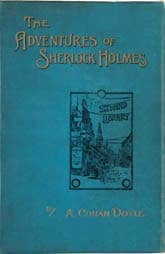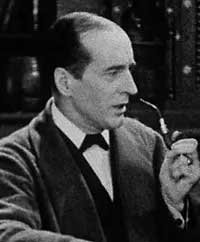The Adventures of Sherlock Holmes
Critique • Quotes • Text • Sherlock Holmes at the movies
 First edition
First editionFirst publication
1892
Literature form
Story collection
Genres
Crime, mystery
Writing language
English
Author's country
England
Length
Twelve stories, approx. 94,000 words

Arthur Wontner, right, is Holmes in five 1930s films, four times with Ian Fleming as Watson.
Iconic Sherlock
Sherlock Holmes (1931–1937): Film series, five films; featuring Arthur Wontner, Ian Fleming (1931–1932, 1935–1937), Ian Hunter (1932)
The first widely acclaimed Holmes of the talking-picture age was Arthur Wontner, who was in late middle-age when he began a series of five films in the 1930s.
Wontner's Holmes is a gentlemanly figure of the contemporary period, offset by a bon vivant Watson, played four times by the smooth Ian Fleming (sometimes credited as Jan Fleming and, no, not the James Bond author). The other time Watson was played by the stiffer Ian Hunter.
The relatively short feature films were shot by American studio Warner Brothers in England with British actors, the plots taken from Doyle's stories and novels, as well as incorporating entirely new material.
Recently discovered origins
The first, The Sleeping Cardinal (1931), combines two middle-period Doyle stories, "The Empty House" and "The Final Problem".
A print of the film has only recently been discovered and it seems not to be widely available on DVD yet, but it may show up on TV channels featuring old movies or classic streaming services, under the Americanized name, Sherlock Holmes' Fatal Hour.
Today's viewers may find The Sleeping Cardinal slow and ponderous, with a too obvious conclusion, but for its time it must have been enthralling. And perhaps Holmes is too kindly, too soft-spoken, for the solitary, eccentric genius we've come to know and love.
But Wontner pretty well created in this film the look and manner of the intelligent screen character that future actors would try to match. And Fleming is a capable, if dapper, partner in detection.
Novel treatment
This was followed in 1932 by The Sign of Four. It contains the basic elements of Doyle's identically named novel, though told in a different order: while the novel starts with our detecting duo entertaining the fatherless young woman with a note promising her riches, the screenplay first gives us the background tale of the men, including her father, who find a treasure and fall out over it with deadly consequences—which removes (for the viewer) some of the need for Holmes's detection.
The movie Watson, played this once by Hunter, does however fall in love and proposes marriage in the end as the book Watson does. When Holmes is perplexed by this eventuality, Watson gets to return, "Elementary, my dear Holmes, elementary," putting a twist on the phrase he's put up with a couple of times already.
Again the film is somewhat leisurely and melodramatic for a modern audience, and the sound—at least on the available DVD—is horrid. But it does open up the action a bit, including some chase and fight scenes, as well as some delightful episodes with a disguised Holmes that might still surprise you.
Case of the missing Sherlock
Next up should be Wontner's The Missing Rembrandt, adapted from the story "The Adventure of Charles Augustus Milverton" and with Fleming back. But you might never get a chance to see this possible masterpiece as its prints are...well, missing.
The villain makes the hero
The Triumph of Sherlock Holmes (1935) is adapted from Doyle's novel The Valley of Fear, which takes place mainly in the United States and in which Holmes appears only about a third of the time. But the film pretty well sticks with him in Britain.
The American story here is told by a main character (not Watson) and dramatized as a flashback about halfway through the story.
This adaptation also drags in Holmes's arch-nemesis Professor Moriarty, who is not in Doyle's book, in the person of the veteran Welsh actor Lyn Harding (who'd been a different villain in 1931's The Speckled Band). This actually appears grafted on, as even some of the other characters comment that the mystery seems to have nothing to do with Moriarty.
But in this version of Valley of Fear Holmes is of course proven right about the professor's involvement.
And, truth be told, Harding plays a great villain and adds some drama to the flick.
Going out in a blaze of mediocrity
The last film in the series, Murder at the Baskervilles (1937), is partly adapted from "Silver Blaze", the lead story in Doyle's second Holmes collection, and was originally called Silver Blaze. But after Basil Rathbone's The Hound of the Baskervilles became a big hit, the name of Wontner's film was changed for the American market to capitalize on the connection.
The Silver Blaze story is changed drastically from the book, bringing in elements of Doyle's novel The Hound of the Baskervilles. The story supposedly takes place twenty years after the Hound case and Sir Henry Baskerville has invited Holmes and Watson for a return visit. While there, the duo find themselves involved in the racehorse-stealing affair outlined in "Silver Blaze".
Once again, Lyn Harding is imported into the story as Moriarty, the brains behind the crime. This confuses the storyline even further for fans of Doyle's writing since the arch-villain Moriarty has already been eliminated at this stage of the books and, in any case, it's hard to imagine what Moriarty could have to do with the largely American-based events.
This most widely available of the Wontner films may not be the the best Holmes vehicle for him to go out on. However, despite the frustrating plot for Sherlockian purists, Murder at the Baskervilles is worth viewing to see how he laid down the template for all would-be Holmeses to follow.
Scenes from Arthur Wontner's Murder at the Baskervilles in 1937.
This and other available Wontner films are in generally poor condition, with sound especially deteriorated. The mysteries are rather slow moving and the production stagy, as might be expected in such early movies. But many consider Wontner the Holmes who comes closest to Doyle's conception in the black-and-white days of movie-making.
After Wontner's reign, Rathbone developed the character in a different direction and became a more contemporary Holmes in the public mind.
But, speaking of Wontner and Rathbone, here's an interesting tidbit for film fans: did you know the two had once acted together on stage? And been arrested together?
In 1926 they had both appeared in New York in The Captive, a play that touched on lesbianism. After running for seventeen weeks, the production became the target of a local politician and the cast were arrested for immorality. Charges were dropped after theatre management agreed to shut down the play.
Taught them a lesson, I suppose, as they both turned to roles as defenders of the law.
— Eric
Critique • Quotes • Text • Sherlock Holmes at the movies
1922, 1929–1933, 1931–1937, 1939–1946, 1954–1955, 1959–1984, 1962–1992, 1965, 1970, 1975–1988, 1976, 1979, 1982, 1984–1994, 2000–2002, 2002, 2002b, 2009–2011, 2010–2017, 2012–2019, 2015


